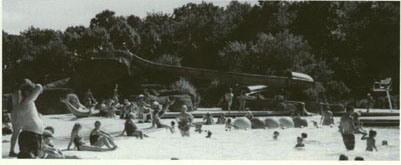Demographic Considerations
It is important to view the financial data in a demographic context. To illustrate, consider two identical facilities: one in a rural community and the other in a crowded, affluent suburb. Even before taking a close look at finances, we probably assume that these facilities will have very different financial performances.
Agencies identified the year that they built their facility or the last time it underwent significant renovations. Traditional pools ranged in age between 13 and 71 years. In contrast, FACs ranged between 2 and 11 years.
We computed facility attendance on the number of people who enter a facility during period of open swim." Since the reporting period for the survey was the summer of 1995, by any measure one of the hottest and driest on record, the attendance data has to be considered extreme. Traditional pools reported attendance ranging from 4,500 to 70,130 while FACs reported between 26,021 and 83,000.
Like the facilities themselves, the communities represented in the study encompass a range between rural and midsized suburbs. Yet, there seemed to be no significant difference in demographics between the communities with traditional pools and those with FACs. Populations served by the pools ranged from 2,000 to 35,000. The FACs served populations between 8,500 and 39,000. Average population per square mile for the traditional swimming pool communities was 2,750 compared with 2,465 for the FAC communities.
Design Does Not Guarantee Profit
The study showed that out of 16 traditional pools examined for essentially the same period, 6 showed a positive return. Of the 9 FACs studied for the same period, 6 showed a deficit. On the surface, one could conclude that design alone is not a sufficient factor to assure the profitability of an aquatic facility.
The surprising results of the study raise two questions. First, why did some traditional swimming pools in the study make money? The commonly held belief holds that they should cost more to run than they produce in revenue. Yet, some of these facilities were not only profitable but astonishingly so. Second, why did some FACs in the study lose money? The commonly held belief holds that they should at least break even. Moreover, given the extreme weather of 1995, most should have produced hefty surpluses. The answer to these questions is that other factors must affect a facility's profitability besides its design.

Although it would difficult to prove, it is arguable that the success of an aquatic facility has at least as much to do with the expertise of the management as it does with the design. We could make the case that excellent management could make the most of a traditional swimming pool, even if it cannot make it profitable. Extremely poor management can run even a great facility into the ground. The problem with this notion is that management expertise is virtually impossible to quantify.
The fact that so many traditional pools posted positive returns on expenses is less surprising when we examine these facilities more closely. Palls Pool, the most profitable facility, does not meet the criteria to be considered a FAC. When they built it in 1972, it was a traditional rectangular swimming pool, although a very large one. However, renovations have added a flume slide to the facility. While one slide does not make it a waterpark, it might give the facility an edge in profitability. Of the 8 pools that posted positive returns on expenses, 5 have unique features that, while not meeting the definition of a FAC, might provide an edge.
Yet, features alone apparently do not guarantee profitability The study showed this in two ways. The two FACs that did not post positive returns on expenses demonstrate this. It is also shown by the two pools, Roxana and Plainfield, that posted surpluses in spite of being as simple in features as swimming pools get.
Facility size may be considered a factor in profitability since the three most profitable facilities (two pools and one FAC) had maximum bather loads more than 1,000. The average facility in the study had total seasonal attendance around 50 times their maximum bather load. Facilities with the largest ratios of attendance to capacity were more likely to be profitable. However, this line of reasoning cannot explain Zion's lack of profitability. Zion had a moderately high capacity and very high attendance yet failed to post a positive return on expenses. The largest ratio is also an aberration. Norridge's swimming pool was one of the smallest facilities in the study. Yet, Norridge managed to pull in the second largest attendance figures of any of the traditional pools, 126 times their maximum bather load. Consequently, size alone also cannot be considered a guarantee of profitability.
One could argue that the size and density of a community should have some influence on the profitability of that community's aquatic facility. Alter all, should we not expect that an aquatic facility within walking distance of 10,000 homes would stand a greater chance of success than one within walking distance of only 1,000 homes?
However, the study does not bear out